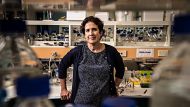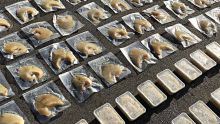It was a gut feeling that had Professor Jennifer Byrne flipping open her computer on a Saturday night and firing up the medical equivalent of a Google search.
What she found made her sick to her stomach.
More NSW News Videos
Suspicious scientific papers under the microscope
Professor Jennifer Byrne, Head of the Childrenâs Cancer Research Unit at The Children's Hospital at Westmead, has uncovered alleged research fraud.
The children's cancer expert had stumbled upon what appeared to be potentially widespread research fraud.
In a world of fake news, where opinion is given as much weight as empirical evidence, and scientists as much consideration as shock jocks, research fraud is a damaging tinderbox for truth.

"I was just horrified. I thought, 'My God, what have I found'," said Professor Byrne, head of the Children's Cancer Research Unit at the Children's Hospital Westmead and University of Sydney academic.
The professor of molecular oncology had turned science sleuth, identifying a total of 48 papers published in scientific journals sharing uncanny similarities, flaws and mismatched data all by independent researchers in China.
Professor Byrne first noticed something was amiss in 2015 when a few too many papers were popping up purporting to study a gene she was very familiar with - LPD52L2 (L2) - having been the first to identify it almost 20 years ago.
"At first I thought it was the same paper, they were so similar. But then I realised there were five of them," she said.
L2 is something of an "orphan" gene with an unknown function that could have implications for cancer treatment, but it doesn't attract a lot of attention.
The way the papers reported their findings and the flaws in their sequences were strikingly similar, Professor Byrne found.
Their poor English and grammar, the strikingly similar references and their seemingly superficial experiments set off alarm bells.
Professor Byrne dug deeper, finding the same sequences were being used for completely different purposes: a sequence used as a positive control in one research paper was used as a negative control in another.
"You don't have to be a scientist to know that's a major logical flaw," Professor Byrne said.
"In many cases it was highly unlikely or impossible that they could have obtained the results they obtained," she said.
She wrote to the four journals that had published the papers. Two journals investigated and one issued a retraction. The authors of the paper admitted they had obtained their data from a commercial biotechnology company without disclosing this partnership.
This was just the tip of the iceberg.
Professor Byrne's Saturday night search on the medical research aggregation site PubMed led to the discovery of another 43 papers that shared highly dubious similarities.
The papers all described single gene knockdowns - a technique used to modify a gene using RNA.
The uniformities were as glaring as the authors' choice of title, the data, descriptions, images, table layouts, even the font and bolding of specific annotations.
Often, the papers' text wouldn't match the data in the tables, again suggesting the authors had obtained their data form a third party, most likely an undisclosed biotechnology company.
Professor Byrne and her colleague computer scientist Cyril Labbe at the University of Grenoble Alpes, France, published their findings in Scientometrics.
"I think we also have to recognise that until we actually prove the origins that we discuss in the paper I guess the authors have a right to be presumed innocent to an extent," Professor Byrne said,
"I'm hoping that at least some of these papers will prove to have been performed by the authors as they described in their papers."
But she suspected there were hundreds of papers with similar flaws.
Under-investigated genes that attracted little attention could be fertile ground for researchers under overwhelming pressure to "publish or perish", Professor Byrne said.
Career security can hinge on the number of published works a scientist has produced. Chinese researchers may be especially vulnerable, with many institutions setting strict quotas for their scientists.
The papers were also published in journals that are fairly low down on the list of prestigious titles, and may have lower standards for publication.
The damage done by research fraud cannot be understated, Professor Byrne said.
"Science runs on brainpower and funding but also trust," she said.
"I need to believe the researchers are doing what they say they're doing. I'm not in their lab staring over their shoulders, and if I can't be confident that what I'm reading is correct I may as well go and work at my local shopping centre.
"The public needs to trust what we do. Governments need to trust what we do, especially in this 'post truth' world where experts are shot down and dismissed so easily," she said.
The papers, like the bulk of published research, urges others to continue their work.
Researchers who are waylaid by trying to replicate faulty data could have been working towards findings that may have had a real impact on the lives of patients.
"They could be following up complete rubbish. It violates everything you're working towards," Professor Byrne said.















